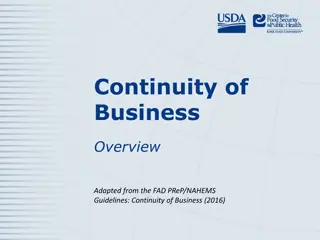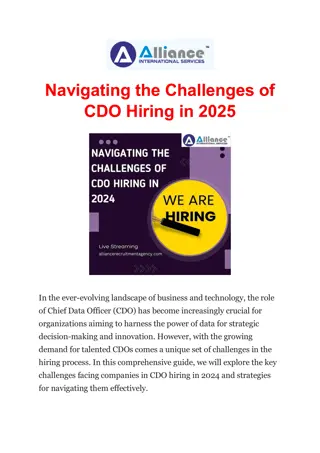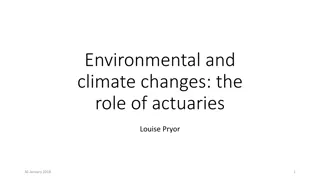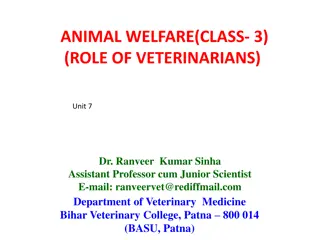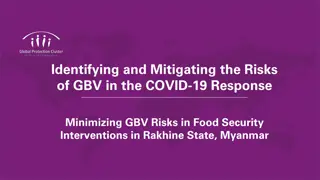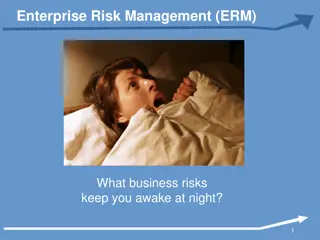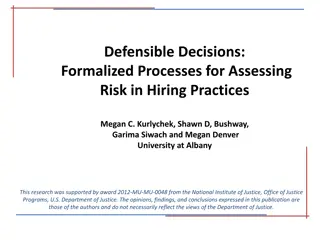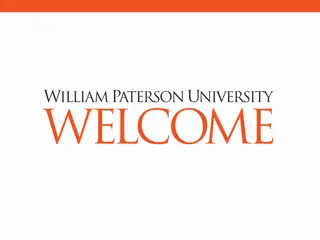Best Practices for Mitigating Risks in Animal Research Hiring
Explore the risks associated with hiring in animal research, such as infiltration by activists, and learn the best practices to mitigate these risks. Understand the impact of unsuitable hires and review strategies to enhance recruitment processes in this sensitive environment.
Download Presentation

Please find below an Image/Link to download the presentation.
The content on the website is provided AS IS for your information and personal use only. It may not be sold, licensed, or shared on other websites without obtaining consent from the author. Download presentation by click this link. If you encounter any issues during the download, it is possible that the publisher has removed the file from their server.
E N D
Presentation Transcript
Mitigating Risks in Animal Research through Hiring Best Practices Division of Human Resources
Objectives Review the current animal research environment Identify recruitment and hiring best practices that will mitigate risks Review post-hire next steps Review the impact of unsuitable hires
Animal Research Environment 250 Animal Rights Movement (ARM) groups ARM raises an estimated $240 million per year 1990 s - ARM responsible for majority of terrorist acts committed in the United States ARM is responsible for $90 million in property damage Source: National Association for Biomedical Research - Crisis Management Manual (2007)
Animal Research Environment Activists recruit current staff to infiltrate target areas Activists target animal research facilities through employment Once employed, activists will: Gain access to research animals Create undercover videos and photos Disrupt research initiatives and projects Malign the reputation of the University
Targeted Risks Position/Responsibility/Role Safety Risk Employment Infiltration Risk Primary Investigator (PI) overseeing targeted research High* Low Senior Administrative Leaders (President, Dean, Program Directors) High Low Research Associates/Assistants and others who directly support (PIs) and/or their research Moderate Moderate Operational Managers responsible for facilities, security Moderate High Lab Employees, Operations, Administration, Student Employees Low High *Note: Visibility from media exposure or high-profile publications can sometimes increase this risk Source: Wake Forest University Risk Management Services Workplace and Home Safety Guide for Research Staff (2010)
Hiring Best Practices To Mitigate Risks
One of the most important decisions a department will make is who to hire.
General Hiring Statistics 30% of applications contain false information. 40% of the information on a resume is misrepresented. 75% of performance problems can be linked back to hiring decisions. Source: Based on American DataBank's research statistics (2008-2010) Average settlement of a negligent hiring lawsuit is nearly $1 million. (private and public sector) Source: Society for Human Resource Management (2008)
A candidates past is your company s (organization s) future. Make sure you know it. Source: Joel Adams, President and CEO of Devon Consulting (2006)
Posting Position Description and Summary Initial screening tool Address pre-employment conditions (e.g., background check, physical exam) , work environment, and culture Utilize posting specific questions based on preferred qualifications Cite guidelines and regulations that the department adheres to
Animal Welfare Laws and Policies (Associated with all NIH/DHHS funded animal research programs regulated by the Office of Laboratory Animal Welfare) Health Research Extension Act of 1985, Public Law 99-158, November 20, 1985, "Animals in Research http://grants.nih.gov/grants/olaw/references/hrea1985.htm U.S. Government Principles for the Utilization and Care of Vertebrate Animals Used in Testing, Research, and Training http://grants.nih.gov/grants/olaw/references/phspol.htm#USGovPrinciples Public Health Service Policy on Humane Care and Use of Laboratory Animals http://grants.nih.gov/grants/olaw/references/phspol.htm The Guide for Care and Use of Laboratory Animals, NRC, Eighth Edition, 2011 http://www.nap.edu/catalog.php?record_id=12910 Animal Welfare Act, as amended, and implementing Animal Welfare Regulations (Title 9 CFR, Chapter I, part 1-4) under the USDA APHIS Veterinary Services http://www.aphis.usda.gov/animal_welfare/awa_info.shtml
Screening Pre/Post-Screening ARM Applicant Red Flags Criminal Conviction Certification Education and Experience Requirements (e.g., Lab Animal Tech) Reference Checks Background Checks Review UNM and/or UNMH Personnel File Social Media
Interviewing Interview Initial contact Review department s values and mission statement Interview questions Non-verbal communication Facility tour
Final Selection Tentative verbal offer Non-selected applicants Summary of hire
Post-Hire Next Steps Prepare for your new hire Establish department expectations Prepare work area Departmental orientation Probation/Trial Period HR Reports (Probation expiring within 6 months/Trial expiring within 30 working days)
Financial Impact of Unsuitable Hires American Management Association reports cost of turnover is estimated at 25% to 250% of employee s salary Separation costs Replacement costs Training Loss of productivity Compromise of research and experiments Intangible Costs
Resources - University Policies Title of Policy Policy Number Link to Policy Use of Animals in Education and Research Regents Policy 5.15 UNM Regents' Policy Manual 5.15 - Use of Animals in Education and Research Hiring, Promotion and Transfer Regents Policy 6.2 UNM Regents' Policy Manual 6.2 - Hiring, Promotion and Transfer Equal Opportunity and Affirmative Action UBPPM #3100 http://www.unm.edu/~ubppm/ubppmanual/310 0.htm Employee Classification UBPPM #3200 http://www.unm.edu/~ubppm/ubppmanual/320 0.htm Recruitment and Hiring UBPPM #3210 http://www.unm.edu/~ubppm/ubppmanual/321 0.htm Background Checks UBPPM #3280 http://www.unm.edu/~ubppm/ubppmanual/328 0.htm Wage and Salary Administration UBPPM #3500 http://www.unm.edu/~ubppm/ubppmanual/350 0.htm Campus Violence UBPPM #2210 http://www.unm.edu/~ubppm/ubppmanual/221 0.htm
Additional Resources National Association for Biomedical Research (NABR) http://nabr.org/ Division of Human Resources http://hr.unm.edu/ HR Presents http://hr.unm.edu/abouthr/hrpresents.php Recruitment Services http://hr.unm.edu/employment/recruitment-services.php UNMJobs Department Resources http://unmjobsresources.unm.edu/departments.php Employee and Organizational Development (instructor led or online training) http://hr.unm.edu/eod/consulting.php UNMJobs Department Originator Best Hiring Practices Designing a Recruitment Plan Effective Interviewing Office of Equal Opportunity http://www.unm.edu/~oeounm
ARF Values & Mission Statement The primary function of the Animal Resource Facility (ARF) is to provide the best possible animal care and to assist investigators in fulfilling their obligation to plan and conduct animal research in accord with the highest scientific, humane, and ethical principles. We sustain these objectives through the development and maintenance of a comprehensive, high quality animal care and use program, which is fully accredited by the Association for the Assessment and Accreditation of Laboratory Animal Care International (AAALAC) and in compliance with all Federal, State and Local laws pertaining to animal welfare and laboratory animal research. *







